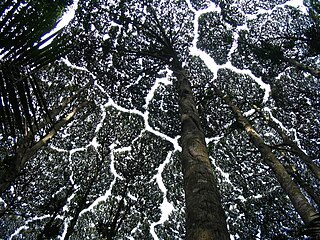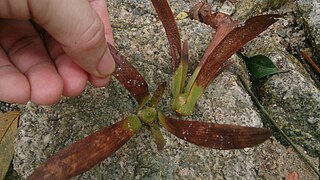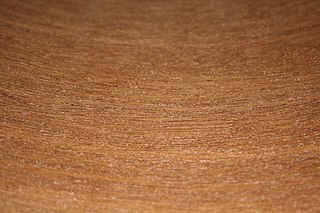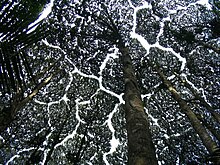
Cinnamomum burmanni, also known as Indonesian cinnamon, Padang cassia, Batavia cassia, or korintje, is one of several plants in the genus Cinnamomum whose bark is sold as the spice cinnamon. It is an evergreen tree native to southeast Asia.
Anisophyllea disticha is a plant of tropical Asia in the family Anisophylleaceae. The specific epithet disticha is from the Latin meaning "2-ranked", referring to the leaf arrangement.
Brackenridgea palustris is a tree in the family Ochnaceae. The specific epithet palustris is from the Latin meaning "swampy", referring to the species' habitat.
Hopea sangal is a tree in the family Dipterocarpaceae. It is native to tropical Asia.

Dryobalanops is a genus of flowering plants and the genus of family Dipterocarpaceae. The name Dryobalanops is derived from Greek and describes the acorn-like nut. The genus has seven species, confined to the tropical forests of West Malesia. It is among the most abundant species of emergent trees in these forests, growing up to 80 m tall.
Dryobalanops beccarii, or Kapur Keladan, is a species of plant in the family Dipterocarpaceae. The species is named after Odoardo Beccari, 1843–1920, an Italian explorer and botanist. It is found in Peninsular Malaysia and Borneo. It is a large emergent tree, up to 65 m tall, found in mixed dipterocarp forests on shallow leached soils over both sandstone and shale. It is a heavy hardwood sold under the trade names of Kapur. It is recorded from at least four protected areas.
Dryobalanops fusca is a species of plant in the family Dipterocarpaceae. The species name fusca is derived from Latin and refers to the dark coloured indumentum. This species is endemic to Borneo, where it is threatened due to habitat loss. It is a large emergent tree, up to 60 m tall, found in kerangas forests on raised beaches. It is a heavy hardwood sold under the trade names of Kapur.
Dryobalanops keithii is a species of plant in the family Dipterocarpaceae. The species is named after H.G. Keith, 1899–1982, a Conservator of Forests in North Borneo. This species is endemic to Borneo, where it is threatened due to habitat loss. It is a main canopy to low emergent tree, up to 40 m tall, found in mixed dipterocarp forest on well-drained but moist clay soils. It is a heavy hardwood sold under the trade names of Kapur.

Dryobalanops lanceolata is a species of plant in the family Dipterocarpaceae. The species name is derived from Latin and refers to the shape of the leaf. This species is endemic to Borneo. It is common in protected areas, although elsewhere it has suffered modest population decline due to logging and land conversion.
Dryobalanops oblongifolia is a species of plant in the family Dipterocarpaceae, native to regions of Southeast Asia and Maritime Southeast Asia.
Dryobalanops rappa is a species of plant in the family Dipterocarpaceae. The species name is derived from Iban and refers to the species habitat. This species is endemic to Borneo. It is found in at least one protected area, but is threatened elsewhere due to habitat loss. The IUCN has assessed the species as endangered due to habitat damage by deforestation, mining, agriculture and fires.

Cinnamomum parthenoxylon is an evergreen tree in the genus Cinnamomum, 10–20 m (33–66 ft) tall. It is native to South and East Asia.

ε-Viniferin is a naturally occurring phenol, belonging to the stilbenoids family. It is a resveratrol dimer.

α-Viniferin is a stilbene trimer. It can be isolated from Caragana chamlagu and from Caragana sinica and from the stem bark of Dryobalanops aromatica. It is also present in relation to resistance to Botrytis cinerea and Plasmopara viticola in Vitis vinifera and Vitis riparia. It has been shown to inhibit acetylcholinesterase.

Diptoindonesin A is a C-glucoside of ε-viniferin isolated from the two Dipterocarpaceae Shorea seminis and Dryobalanops aromatica.

Kapur is a dipterocarp hardwood from trees of the genus Dryobalanops found in lowland tropical rainforests of Malaysia, Indonesia and South-East Asia. It is a durable construction tropical timber. One variety, D. aromatica, is a source of camphor.
Gonystylus maingayi is a tree in the family Thymelaeaceae.

Pterophylla fraxinea, formerly known as Weinmannia fraxinea, is a tree in the family Cunoniaceae. It grows up to 40 metres (130 ft) tall. The bark is grey to dark brown. Inflorescences bear up to three pairs of flowers. The specific epithet fraxinea is from the Latin meaning "ash tree", referring to the leaves' resemblance to those of the genus Fraxinus.
Castanopsis javanica, the Javan chestnut-oak, is a tree in the beech family Fagaceae. The specific epithet javanica is from the Latin, meaning "of Java".
Hopea dryobalanoides is a tree in the family Dipterocarpaceae. The specific epithet dryobalanoides means "resembling Dryobalanops", referring to that genus of trees and particularly their leaf veins.










